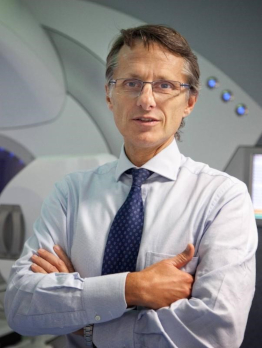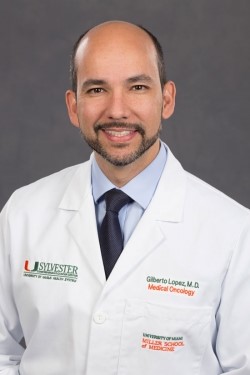Professor Umberto Ricardi, Professor of Radiation Oncology at the University of Turin and Chairman of Oncology Department at the San Giovanni Battista University Hospital in Turin, Italy.

Professor Ricardi is a radiation oncologist whose main areas of clinical and scientific interest include lung cancer, lymphoma, childhood tumours, and central nervous system tumours.
He is an expert in the development of cutting-edge technologies in radiation oncology, including radiosurgery, stereotactic ablative radiation therapy, image-guidance, and volumetric IMRT.
Professor Ricardi is also a member of the Italian Association of Radiation Oncology, the European Society for Radiation and Oncology (currently serving as ESTRO President) and the EORTC Radiotherapy Group. In 2007, he was appointed to the Italian Ministry of Health’s National Oncological Commission.
What first motivated you to work in thoracic medicine and lung cancer?
There were really two factors that led me to thoracic medicine and later lung cancer: the clinical challenge and the technical challenge. When I was in training the prognosis of lung cancer patients was dismal. I believed that it was very important for me as a clinician to try and make the biggest effort possible to improve the prognosis of lung cancer patients. From the perspective of radiation oncology, lung cancer can be a very challenging disease to treat.
What is different about your role today from when you started your career?
A lot has changed over the last 30 years. There have been huge technical advances in the field which have changed my practice in the last two decades. New developments such as stereotactic ablative radiotherapy (SABR) and intensity modulated radiotherapy (IMRT), for instance, have increased the precision and effectiveness of radiation therapy, both in early stage and locally advanced lung cancer. We can precisely target the tumour with a high dose of radiation, while the surrounding healthy tissue receives only a low dose. This has really changed the way we treat patients with lung tumors.
What have been the biggest advances in your specialty, in terms of how we have improved outcomes for people with lung cancer?
Two technical advances have really transformed the way that we work as radiation oncologists. SABR has made it possible to treat small tumours diagnosed at an early stage much more effectively, to the point that you could say we are curing patients without the need for surgery.
For those patients diagnosed with later stage cancers, combination of systemic treatments (platinum-based chemotherapy) and modern radiotherapy (4D-CT scan at simulation, planning with IMRT, image guided radiotherapy) has had a significant impact on outcomes.
In the 1990s, standard treatment for locally-advanced (stage III) NSCLC was radiotherapy alone, with a median survival rate of between 9-10 months; thanks to advances in medical oncology, radiation oncology, and imaging techniques, median survival has improved to around 30 months. This is better, but there is still plenty of room to improve.
What do you see as the most significant challenges to continuing to improve outcomes for people with lung cancer in the coming years?
In my view the biggest challenges are around ensuring access to high quality multi-disciplinary care, education and resourcing. Multi-disciplinary team working offers the optimum standard of care but this varies at a national and an international level. I believe we should be working to guarantee access to high quality multi-disciplinary care for everyone with lung cancer, as well as with other cancers sites.
We also need to educate the next generation of clinicians, ensuring that all the different healthcare professionals caring for people with cancer are well trained and supported to work in a multi-disciplinary way.
This will mean finding new ways of working and pathways of care. For example, roles will need to change to support people who are on active treatment for much longer.
Globally, the availability of resources is also an issue. Patients in some countries simply do not have access to effective and up-to-date treatment. Widening access to new and better treatments and the workforce to deliver them will continue to be a challenge for many countries.
What are you most excited about in your field?
We are finding new ways to better target and treat lung cancer. For example, combining PDL1 inhibitors and radiations is an incredibly exciting new area of clinical research. I feel optimistic about the prospect of finding new ways to combine these medicines with radiation oncology to improve outcomes in different disease settings.
I also feel that the wider use of Patient Reported Outcome Measures (PROMs) is important. By directly capturing outcomes from the perspective of the patient, PROMs have the potential to narrow the gap between the clinician’s and patient’s view of what is needed and help tailor treatment plans to meet the patient’s preferences and needs.
What role do you see international collaboration playing in advances in lung cancer treatment?
International collaboration is fundamental to improving the treatment of lung cancer. In my role, as current President of ESTRO, I see on an almost daily basis how improving collaboration between international societies such as ESTRO and IASLC, is vital to sharing best practice and optimising education and care.
I am certain that international collaboration will allow us to continue to improve multidisciplinarity and patient care across all cancer types.
Professor Gilberto de Lima Lopes Jr, Associate Director for Global Oncology, Sylvester Comprehensive Cancer Centre and Associate Professor of Clinical Medicine, University of Miami in Florida

Prof Gilberto Lopes is a medical oncologist and has dedicated his career to thoracic cancers and the issues of cancer control and access to medications in low and middle-income countries.
He is the editor in chief of the American Society of Clinical Oncology’s (ASCO) Journal of Global Oncology, associate editor for the ASCO University Editorial Board, 2016-2017 chair of the International Clinical Trials Workshop Working Group, and global health track leader for the Cancer Education Committee.
What first motivated you to work in lung cancer treatment?
Cancer made my mother an orphan at 17 years of age. Her mother died of breast cancer and her father had died of a heart attack shortly before. It changed my mother’s life. Once I was at medical school, going into cancer medicine was a natural choice.
My interest in lung cancer developed while I was training. I was fortunate to be a young oncologist at a time of exciting new developments in cancer treatment. We were learning about cancer cells and how they respond to the immune system, and it seemed like an area with real promise for new treatments. I began volunteering in oncology clinics, did laboratory research and it became my career.
What have been the biggest advances in medical oncology, in terms of how we have improved outcomes for people with lung cancer?
There have been two major advances that have revolutionised how we treat patients today: tyrosine kinase inhibitors (TKI) – which work by blocking cancer growth – and immunotherapies – which use our body’s immune system to fight cancer.
Working with new TKI treatments we noticed that some patients, notably women, non-smokers and people of Asian descent, had a much better response to their treatment, with their lives being considerably extended. What we learnt, thanks to the work of two teams in Boston, was that these different responses reflected the role that different genetic mutations in cancer cells (in this case EGFR) play in determining how these cells respond to treatment.
This ushered in a new way of ‘targeting’ cancer treatment to particular mutations in cancer cells such as EGFR, ALK, ROS1 and B-RAF, which control the way the cells grow and thus how cancer cells can be treated.
Third generation TKIs, osimertinib and crizotinib, for example, target EGFRs and ROS1 proteins and based on this targeted approach, we’re seeing patients living longer – up to three years, rather than three months, after diagnosis. This really is an amazing development.
We’ve also seen new immunotherapies such as nivolumab and pembrolizumab being used in lung cancer and we’ve again seen patients doing much better than with chemotherapy alone. These treatments target particular cancer cells that have high levels of proteins called PD-1 and PD-L1.
Today we’re learning more about how to use immunotherapy and chemo therapy in combination, which is improving survival even further. We are finding that single treatments are no longer the most effective options for all patients.
What do you see as the most significant challenges in continuing to improve lung cancer treatment?
Cancer resistance is a major challenge. We need better understanding of why cancers become resistant to treatments, and then we can work out how to keep resistance away.
Funding for lung cancer research is also a problem. We know that lung cancer gets less than its fair share, relative to other common cancers. We need more investment in research so we can improve the treatment and care we provide to patients.
What are you most excited about in your field?
Molecular therapies are a game-changer. With further advances in treatment, I believe we can make metastatic lung cancer a chronic disease. We are still a long way off, but one day we will get there.
What role do you see international collaboration playing in advances in lung cancer treatment?
I’ve been lucky to study and work in different countries, so I have seen the way different health systems are confronting lung cancer. International collaboration is paramount. Without international trials and studies, we will not advance as quickly as we could. We have to work together if we’re to make real progress for patients.


